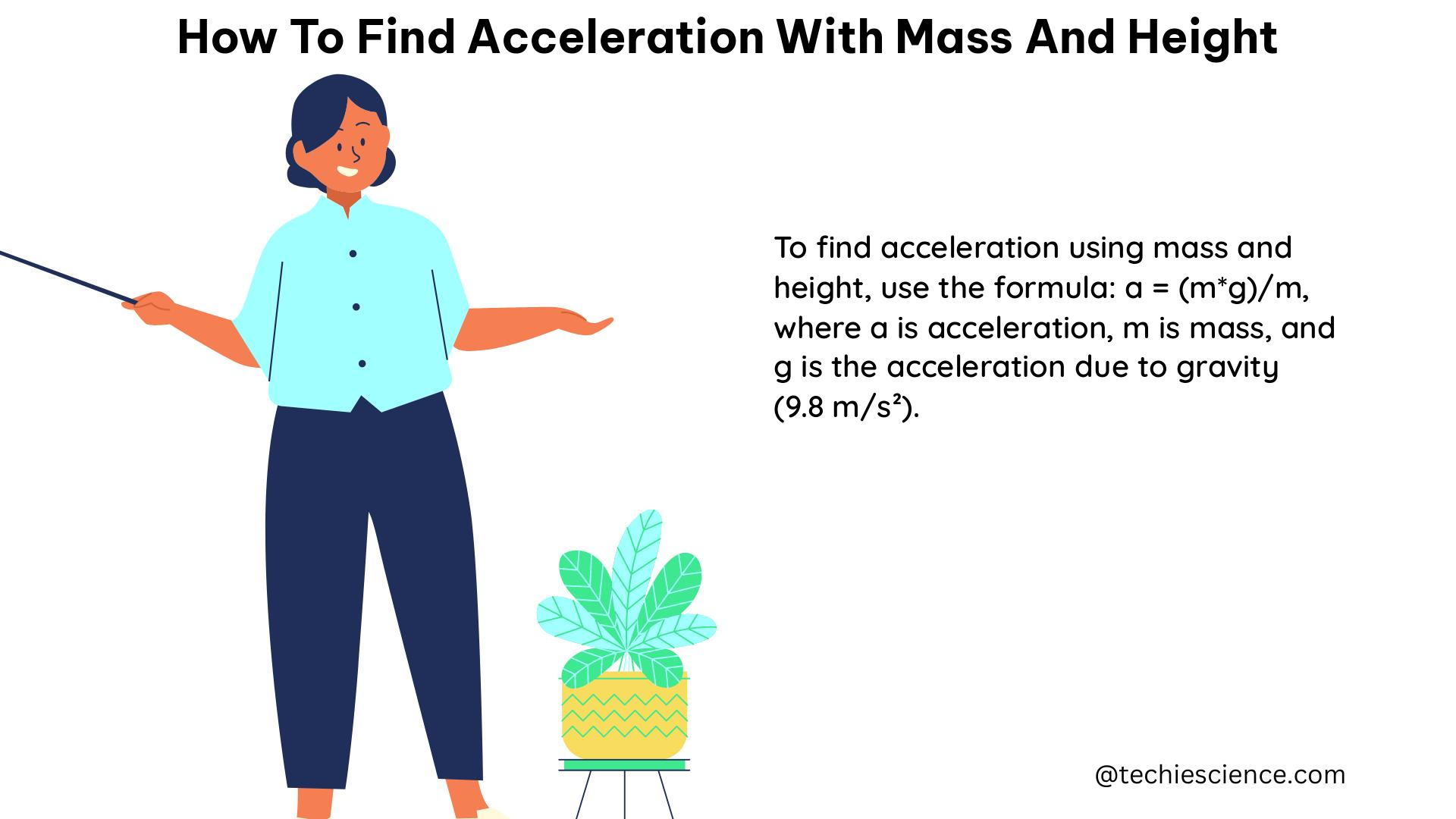Acceleration is a fundamental concept in physics, and understanding how to calculate it is crucial for various applications, from analyzing the motion of objects to designing mechanical systems. In this comprehensive guide, we will delve into the physics behind finding acceleration using mass and height, providing you with a detailed and technical understanding of the topic.
Understanding Acceleration and Gravitational Acceleration
Acceleration is defined as the rate of change in velocity over time, represented by the equation a = Δv/Δt, where a is the acceleration, Δv is the change in velocity, and Δt is the change in time. In this context, we are specifically interested in the acceleration due to gravity, which is denoted as g.
The formula to find the acceleration due to gravity is:
g = G * (m1 * m2) / r^2
where:
– G is the gravitational constant (6.674 × 10^-11 N⋅m^2/kg^2)
– m1 and m2 are the masses of the two objects
– r is the distance between the centers of the two objects
Simplifying the Equation for a Single Object and the Earth

In many practical situations, we only have information about the mass of a single object and its height from the ground. In this case, we can simplify the equation by assuming that the distance r is the Earth’s radius R, and the mass m2 is the mass of the Earth m_Earth.
The simplified equation becomes:
g = G * (m_Earth / R^2)
where:
– m_Earth is the mass of the Earth (5.972 × 10^24 kg)
– R is the radius of the Earth (6.371 × 10^6 m)
This equation allows us to calculate the acceleration due to gravity based on the height of the object, as the Earth’s radius is a constant.
Considering the Effect of Height
While the variation in height can affect the acceleration due to gravity, the change is usually negligible for most practical purposes. To account for the height, we can use the following formula:
g = (G * m_Earth) / (R + h)^2
where:
– h is the height of the object above the Earth’s surface
For example, if we have an object with a mass of 10 kg at a height of 1000 m, we can calculate the acceleration due to gravity as follows:
g = (6.674 × 10^-11 N⋅m^2/kg^2) * (5.972 × 10^24 kg) / (6.371 × 10^6 m + 1000 m)^2
g ≈ 9.81 m/s^2
As you can see, the change in acceleration due to the 1000 m height is negligible, and the value remains approximately 9.81 m/s^2, which is the standard value for acceleration due to gravity at the Earth’s surface.
Practical Applications and Examples
The ability to calculate acceleration using mass and height has numerous practical applications in various fields, such as:
- Projectile Motion: Determining the trajectory and landing position of projectiles, such as balls, rockets, or artillery shells.
- Falling Objects: Analyzing the motion of objects falling under the influence of gravity, such as dropped items or parachutes.
- Mechanical Systems: Designing and analyzing the performance of mechanical systems, such as elevators, cranes, or suspension systems, where the acceleration due to gravity plays a crucial role.
- Aerospace Engineering: Calculating the acceleration experienced by spacecraft and satellites during launch, orbit, and re-entry.
- Civil Engineering: Estimating the loads and stresses on structures, such as buildings or bridges, due to the acceleration of gravity.
Here’s an example problem to illustrate the application of these concepts:
Problem: A 50 kg object is dropped from a height of 500 m. Calculate the acceleration experienced by the object during its fall.
Solution:
1. Given:
– Mass of the object, m = 50 kg
– Height of the object, h = 500 m
2. Using the formula:
g = (G * m_Earth) / (R + h)^2
g = (6.674 × 10^-11 N⋅m^2/kg^2) * (5.972 × 10^24 kg) / (6.371 × 10^6 m + 500 m)^2
g ≈ 9.81 m/s^2
Therefore, the acceleration experienced by the 50 kg object during its fall from a height of 500 m is approximately 9.81 m/s^2, which is the standard acceleration due to gravity at the Earth’s surface.
Conclusion
In this comprehensive guide, we have explored the physics behind finding acceleration using mass and height. We have covered the fundamental equations, the simplification for a single object and the Earth, and the consideration of height variations. Additionally, we have discussed the practical applications of these concepts and provided an example problem to solidify your understanding.
By mastering the techniques presented in this guide, you will be well-equipped to tackle a wide range of physics problems involving acceleration, mass, and height, making you a more proficient and knowledgeable physics student.
References
- Finding the Dimensional Formula for Acceleration
- Calculating Acceleration from Force and Mass
- Acceleration Tutorial
- Acceleration Calculator Using Force and Mass

The lambdageeks.com Core SME Team is a group of experienced subject matter experts from diverse scientific and technical fields including Physics, Chemistry, Technology,Electronics & Electrical Engineering, Automotive, Mechanical Engineering. Our team collaborates to create high-quality, well-researched articles on a wide range of science and technology topics for the lambdageeks.com website.
All Our Senior SME are having more than 7 Years of experience in the respective fields . They are either Working Industry Professionals or assocaited With different Universities. Refer Our Authors Page to get to know About our Core SMEs.